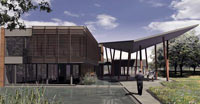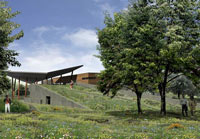Adding Green to Queens Botanical Garden
Queens Botanical Garden Uses Innovative Methods to Promote Sustainable Design
EPA530-F-06-034
September 2006
QBG by the Numbers
- Two new buildings plus landscaping cover more than 22,000 square feet.
- Projected 30 percent water reduction by using water saving features.
- Projected 17 percent electricity savings for visitor/administration building by installing a green roof.
- 90 percent of waste recycled during construction.
- Designed to achieve LEED® Platinum certification.
It’s getting a lot greener in Queens! Though surrounded by the concrete jungles of New York City, Queens Botanical Garden (QBG) merges new technology with natural elements to reduce the environmental footprint of its newest buildings. QBG’s award-winning building design incorporates components like a green roof, composting toilets, and a rainwater harvest system to lessen the impact of its construction and operations. Scheduled for completion in spring 2007, QBG’s Sustainable Landscapes and Building Project serves as an environmentally sound model for future construction plans in New York City.
QBG is using a variety of innovative methods to apply and promote sustainable design. The multitalented design team worked together to develop ideas for a two-phase master plan. Using 10 acres of land, the team prepared concepts for two buildings–the horticulture/maintenance facility and the visitor/administration building–and the surrounding terrain. The models incorporated sun, wind, water, and plants to create an inviting space where visitors can relax and enjoy their surroundings while learning about sustainable behaviors and designs.
Elements of the new buildings, such as a green roof and parking garden, allow for the infiltration, collection, and reuse of rainwater through a rainwater harvest system. These features–along with a gray water system, composting toilets, and waterless urinals–are projected to reduce water consumption by 30 percent. The green roof will reduce the need for heating and cooling and provide additional gardening space. Photovoltaic panels installed on the green roofs capture and use the sun’s energy and are projected to supply 17 percent of the total electricity needs for the visitor/administration building. The visitor/administration building also is designed to achieve the highest (Platinum) level Leadership in Energy and Environmental Design (LEED®) certification from the US Green Building Council and has received the Green Building Design Competition Award, sponsored by the NYC Department of Environmental Protection and the US Environmental Protection Agency.

Visitor/Administration Building featuring terrace, water-collecting roof, and cleansing biotope
Landscaping is also an important component of the green design at QBG. Horticultural staff, trained in sustainable landscaping, will plant woodland, wetland, and prairie plant communities that contribute to the stormwater management system. The staff will incorporate native plants that are adapted to the local environment, which will reduce the need for watering. After the completion of the construction, QBG will move to total organic management of its gardens, transitioning from little to no synthetic pesticide use. Part of the LEED guidelines requires the minimum use of fertilizers and pesticides in landscapes and greenhouses, so QBG will include an Integrated Pest Management (IPM) Plan. Maintaining a minimum number of exotic varieties like banana shrubs, Cuban oregano, plantains, gingers, and other plants is important to one of the most ethnically diverse communities in New York City–about 300,000 people, speaking more than 130 languages or dialects, visit QBG each year–so these plants will be carefully managed through the IPM and sensible watering practices to ensure that they thrive.
The project is as educational as it is creative. “We feel that this project is a good vehicle to teach nonprofit institutions and other organizations how to integrate sustainable landscape architecture and more traditional landscape architecture,” says Ms. Jennifer Ward Souder, director of capital projects at QBG.

Visitor/Administration Building featuring green roof
“One of the biggest challenges thus far has been the learning curve for everyone involved,” continued Souder. “But,” Souder insists, “communication is the key to facing these challenges.” QBG held various educational workshops during the planning stages and kept communication lines open. As construction proceeds, Souder performs a daily walk-through with subcontractors and holds daily and weekly meetings to update each worker. Souder and contractors review the official LEED compliance requirements at each meeting to remind everyone of the goal of the entire project.
QBG also uses an in-house system called “smoothing” to make sure different departments are informed of the correct procedures to follow in certain situations during the construction process. This system includes providing information ranging from how to dispose of materials in environmentally responsible ways to how to purchase recycled-content supplies. Through the smoothing system, employees at all levels appreciate the value of the environmental features of this construction project and are helping to recycle more than 90 percent of the waste generated during construction. QBG also follows a recycling program for everyday operations.
Just as QBG collaborates internally to ensure the quality of the construction project and final product, it also partners with the Queens Borough President’s Office, the Office of the Mayor, and the New York City Council. The New York City Department of Cultural Affairs supports the project and has received New York State Energy Research and Development Authority funding for energy modeling, materials analysis, and assistance with the LEED certification process.
For more information, please contact Jennifer Ward Souder (jsouder@queensbotanical.org), director of capital projects, at 718 886-3800 x220 or Max Joel (mjoel@queensbotanical.org), capital projects coordinator, at 718 886-3800 x223. For a complete listing of the project team or updates on the project, please visit www.queensbotanical.org/sustainable ![]() .
.
View and print this fact sheet (PDF) (2 pp, 196K, about PDF)
Disclaimer: Reference herein to any specific commercial products, process, or service by trade name, trademark, manufacturer, or otherwise, does not necessarily constitute or imply its endorsement, recommendation, or favoring by the United States Government. The views and opinions of authors expressed herein do not necessarily state or reflect those of the United States Government, and shall not be used for advertising or product endorsement purposes.
![[logo] US EPA](../gif/logo_epaseal.gif)